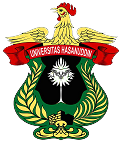SOCIO-ECONOMIC RELATIONSHIP WITH FEEDING PATTERNS FOR STUNTED CHILDREN 24-59 MONTHS IN THE WORKING AREA OF THE MALIMONGAN BARU HEALTH CENTER IN MAKASSAR CITY
DOI:
https://doi.org/10.30597/jgmi.v12i1.26080Abstract
Introduction: Stunting is a linear growth disorder caused by malnutrition and chronic infectious diseases as indicated by a Z-Score for height for age (TB/A) less than -2 standard deviations (SD) based on WHO standards. Objective: To determine the socio-economic relationship (education, employment and income) to the feeding patterns of stunted toddlers aged 24-59 months in the working area of the Malimongan Baru Health Center. Materials and Methods: This research was conducted on 66 stunted toddlers aged 24-59 months in Makassar City using the random sampling method and chi-square analysis using the SPSS application. Results: There is a relationship between mother's education, mother's occupation, father's occupation, and parental income with feeding pattern (p-value<0.05) and there is no relationship between father's education and feeding pattern (p-value>0.05 ) Conclusion: High maternal education, working mothers and fathers, high family income have proper feeding patterns for toddlers compared to low maternal education, mothers and fathers do not work, and low family income.Downloads
Download data is not yet available.
Downloads
Published
2023-05-26
How to Cite
Auliyah, A., Hidayanty, H., Jafar, N., Salam, A., & Trisasmita, L. (2023). SOCIO-ECONOMIC RELATIONSHIP WITH FEEDING PATTERNS FOR STUNTED CHILDREN 24-59 MONTHS IN THE WORKING AREA OF THE MALIMONGAN BARU HEALTH CENTER IN MAKASSAR CITY. Jurnal Gizi Masyarakat Indonesia (The Journal of Indonesian Community Nutrition), 12(1). https://doi.org/10.30597/jgmi.v12i1.26080
Issue
Section
Articles
License

This work is licensed under a Creative Commons Attribution-NonCommercial-ShareAlike 4.0 International License.












